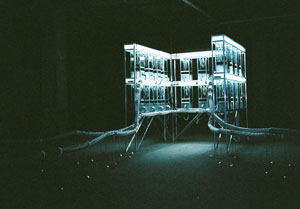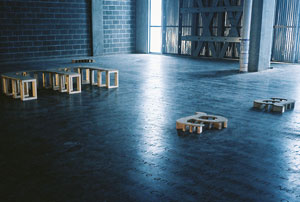Construction Site, the title of an exhibition now on view in downtown Austin, is a bit of a misnomer.
The space and its contents are constructions, to be sure; but the event itself doesn’t recall an actual building zone. Construction Site is not a work in progress. The space, which threatens (but fails) to overwhelm the artwork, is a large, rambling vault — unfinished only in its search for permanent occupants. The sculptures and installations in the show are successful not because they are in any way unfinished, but rather because they have been stretched and pulled to the limits of their own completion.
The space is located on the ground floor of a recently completed retail and residential complex, which is part of the Second Street “entertainment district” in downtown Austin. It’s easy to live in Austin and neglect this new thrill ride because it doesn’t exist in real life. The district exists only on city blueprints, sketched in a frenzy during the flush dotcom years. Partially occupied with residential tenants, the completed building includes street-level space intended for retail but currently, shall we say, available to resourceful artists. Earlier this year, four graduates and near-graduates of the University of Texas at Austin’s MFA studio art program approached the building’s managers to ask for use of the space. They wanted ample room to accommodate large-scale sculpture and installations, work that is rarely exhibited because of its size constraints. This is particularly true in the case of UT’s own lovely but somewhat diminutive exhibition space Creative Research Laboratory, which does good shows but is really not up to the task of serving such a large art department. That being the case, these graduates and near-graduates took it upon themselves to locate a space of their own; and, independent of the school, convinced an initially skeptical building management to allow the exhibition in the space.
Katalin Hausel, Young-Min Kang, Barna Kantor, and Lynn Richardson have maximized their opportunity. Over the summer, they transformed the space, which is punishing and brightly lit. An unformed, warehouse-like structure, the site could only succeed as an exhibition space insofar as the artists (and the artwork) didn’t back down. Remarkably, the work is aggressively executed but sensitively formed. It is huge and bulky, hardy and risky — but it is also achingly beautiful.
Lynn Richardson’s Air Distribution Center is a collection of sculptural pods, arranged across the floor in various states of undress. These radiant, organic shapes retain their earthiness even with an enormous clinical machine and tentacle-like tubes behind them. Richardson encourages the viewer to walk through this alien landscape. The machine’s lit compartments suggest laboratory cabinets, and the viewer instinctively peers inside to see what’s going on. Nothing is actually happening, and that’s largely the point. By eschewing some kind of dogmatic point about medicine / technology / industrialization, Richardson forestalls any desire in the viewer to point moral fingers, allowing the piece to be simply a touching response to the environment.
To some extent, all the work in Construction Site depends on human interaction and audience participation, but Barna Kantor’s pieces don’t exist without it. A lot is happening in Kantor’s work, and the bulk of this activity changes on its own, or as the viewer changes. The Chilling Station features two panes of fans hung in close proximity, and the result is an optical fun house that changes with the slightest shift in the viewer’s position. Move an inch to the left, and the fans on the right seem to slow down or stop altogether, and the shapes morph seamlessly. Retinal Massage I uses two projectors mounted on Dubnoff Metabolic Incubators (stainless boxes that jiggle things at very fast speeds), which results in a cast image that approximates the visual pattern of macramé. If you stand in front of the projectors, the shape of your body appears enmeshed in the pattern, only to hop across the wall a moment later, while you remain still.
Young-Min Kang’s portrait of our Commander-in-Chief, George, is a successful re-orientation of this much-seen face. The portrait is gigantic, by far the tallest piece in the show. Sectioned into long, thin sheets hung from the ceiling, President Bush’s visage is cut up, unrolled, and reorganized. He’s recognizable, but unnervingly distorted. On the opposite side of the room is another piece that depends on movement, Slice of a Day is a huge three-dimensional trapeziod covered with the image of an elongated, digital face. The angular image is mounted on a thin pole which rotates from a motorized base. The portrait’s digital roots and its extreme extension into space suggest a sweeping reach towards infinity.
![]()
Housed in a quiet room off to the side of the main space, Katalin Hausel’s installation Drift is a restful interaction between the floor and the audience. Hausel has carefully stenciled words from Noam Chomsky’s essay “The Responsibility of Intellectuals” directly on the floor; and periodically, a single letter is manifested in 3-D, like a wooden alphabet stool. There’s a certain intended awkwardness in walking across the floor (or resting on the seats), and Hausel exploits this tension. The text controls human movement as the viewer tries to read and walk across the room. The afternoon I visited the exhibition, a ferocious thunderstorm flooded the space. The water stood still in pools, threatening to lift the letters off the floor and lending the installation a lovely (albeit accidental) transitory quality, which was absent from the robust work found elsewhere in the exhibition.
The lofty aims of this exhibition, its encouragement of contemplation and meditation, never fall flat. All four artists are courageous: they have created an unflinchingly conceptual show without neglecting the works’ interior life. This is a rare exhibition that is both elegant and brave: confident in its talent, practically brazen in its construction, and, ultimately, modest in its beauty.
Construction Site’s hours are Thursday to Saturday noon to 8pm and Sunday by appointment. There is also a closing party on September 25 from 8pm to the wee hours in conjunction with Cinematexas. These artists also produced a very nice catalogue for the exhibition with an essay written by Amanda Douberley, current Core critical studies fellow. Contact the artists directly for more information [email protected], [email protected], [email protected], and [email protected].
Images courtesy the artists.
Marie-Adele Moniot is a writer and graduate student living in Austin.






